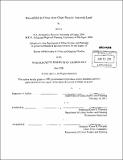Brownfields in China : how Cities recycle industrial land
Author(s)
Li, Xin, Ph. D. Massachusetts Institute of Technology
DownloadFull printable version (13.23Mb)
Alternative title
How Cities recycle industrial land
Other Contributors
Massachusetts Institute of Technology. Dept. of Urban Studies and Planning.
Advisor
Karen R. Polenske.
Terms of use
Metadata
Show full item recordAbstract
Since around 2000, China has been experiencing a major shift in its industrial bases. Many cities have been relocating polluting and energy-intensive plants from urban areas to the less-developed periphery. In the summer of 2005, when I started to pay attention to industrial relocation cases in China, I found that the issue of urban land contamination was not of much concern to either the general public or the government, not even Chinese environmental scholars. I found little evidence that, among relocation projects, former industrial land was properly monitored and treated before construction. Although problems with polluted land have been widely studied in developed countries, this field has remained virtually untouched in China until recently. These industrial sites, usually polluted, are considered brownfields. Without a comprehensive brownfield redevelopment regulatory system in China, I have also observed inconsistence in local environmental activities in dealing with potentially contaminated land. I answer the following four questions: (1) Given the absence of a strong national/provincial brownfield legislative system, why are some brownfields remediated while some are not?; (2) How can the interactions among polluting factories, profit-driven developers, and public agencies affect the outcome of various stages in the land-recycling process? (3) What are the sources of variation in land recycling projects even within the same city? and (4) What institutional arrangement is favorable to pollution remediation? My argument is that, rather than solely relying on reform from the top, local governments have the ability to ensure a sustainable and healthy industrial land redevelopment. Through three case studies of relocation projects (the Capital Iron and Steel Plant, the Beijing Coke Plant and the Beijing Chemical Plant), I find some institutional changes which were not designed initially for brownfields are conducive to more effective and efficient management of land contamination. These changes, such as the introduction of the Land Consolidation and Reserve Center and the auction system, have promoted a transparent decision-making process, increased involvement of civil society, and effective inter-agency communication, all of which reinforced my hypothesis that a relatively balanced participation in decision making among stakeholders involved in land-recycling projects leads to sustainable land recycling.
Description
Thesis (Ph. D.)--Massachusetts Institute of Technology, Dept. of Urban Studies and Planning, 2011. Cataloged from PDF version of thesis. Includes bibliographical references (p. 167-174).
Date issued
2011Department
Massachusetts Institute of Technology. Department of Urban Studies and PlanningPublisher
Massachusetts Institute of Technology
Keywords
Urban Studies and Planning.
